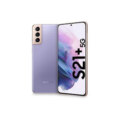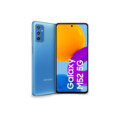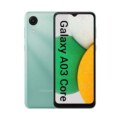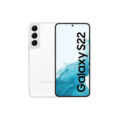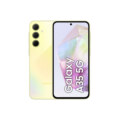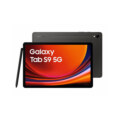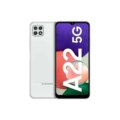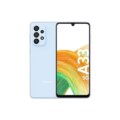Samsung Galaxy M11
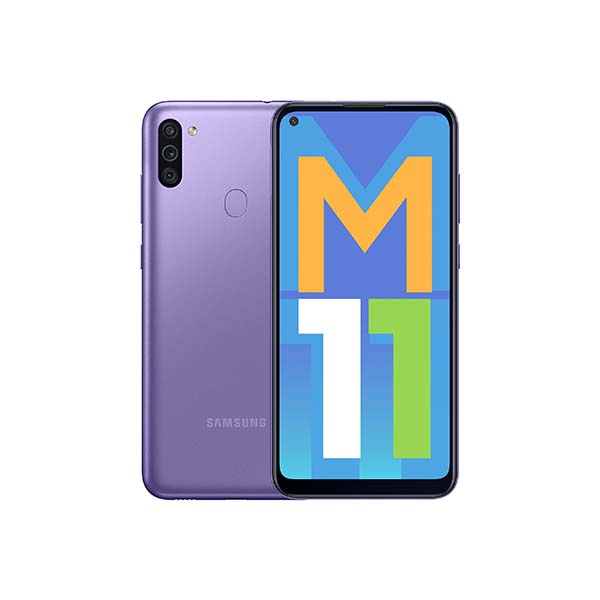

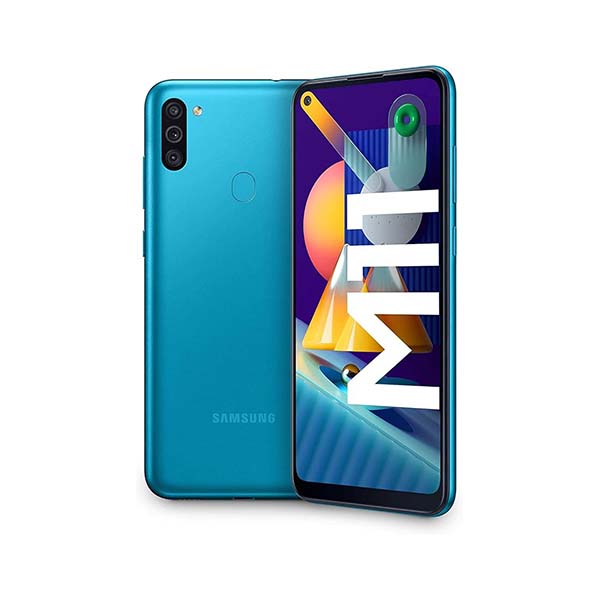
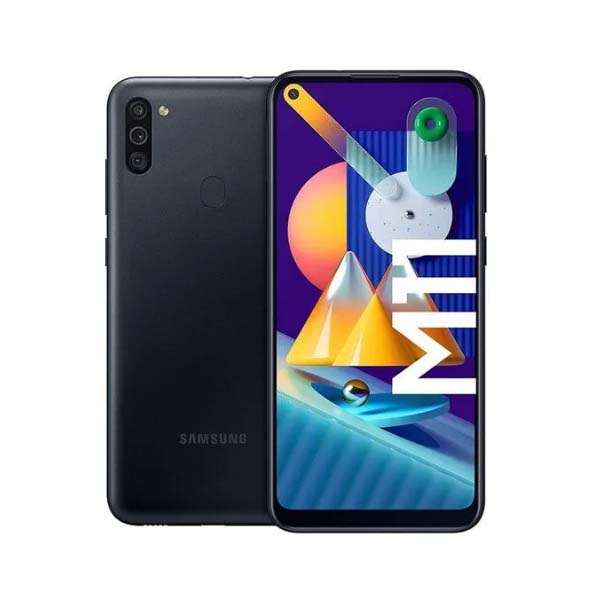
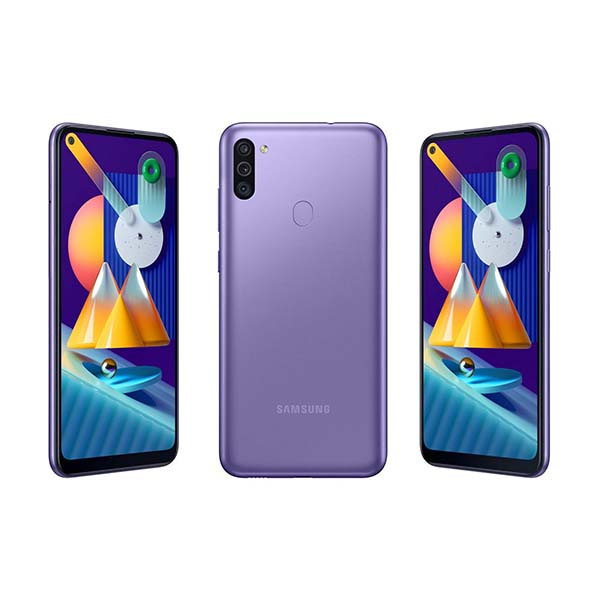
Specs
General
| Device Type | Smart Phone |
| Model | SM-M115F, SM-M115F/DSN, SM-M115M, SM-M115M/DS |
| Announced | 30 March, 2020 |
| Released | 22 April, 2020 |
| Status | Available |
Design
| Dimensions | 161.4 x 76.3 x 9 mm |
| Weight | 197 g |
| Protection | Glass front + Plastic back |
| Colors | Black, Metallic Blue, Violet |
Display
| Refresh Rate | 60 Hz |
| Display Type Display Technology => A number of display technologies and types used in mobile phones => TFT (Thin Film Transistor), IPS (In-Place Switching), OLED (Organic Light Emitting Diode), AMOLED (Active-Matrix Organic Light-Emitting Diode), Super AMOLED (an even advanced version of AMOLED), Resistive Touchscreen (Resistive touchscreens contain two layer of conductive material with a very small gap between them which acts as a resistance), Capacitive Touchsceen (Capacitive touchscreen technology consists of a layer of glass coated with a transparent conductor) | PLS TFT LCD |
| Size | 6.4 inches (16.26 cm) |
| Resolution | 720x1560 px (HD+) |
| Display Colors Display Colors is refers to the number of different shades of colors that the screen is capable of displaying => 64K colors, 256K colors and 16 million colors, Obviously 16M is highest available range of colors and better than others. | 16M colors |
| Pixel Density Pixel Density (PPI) is refers to the concentration of pixels on a particular display, measured in pixels per inch (ppi). Pixel density is calculated by dividing the diagonal pixel resolution of a display by its diagonal size, higher pixel density better display quality. | 268 ppi |
| Touch Screen | Yes, Capacitive Touchscreen, Multi-touch |
| Display Protection Display Protection => Gorilla Glass is a special alkali-aluminosilicate glass shield with exceptional damage resistance that helps protect mobile displays from scratches, drops, and bumps of everyday use, It is always better to go for a smartphone with Gorilla Glass for that added protection and peace of mind. | gorilla glass |
| Features | Active noise cancellation with dedicated mic |
Camera
| Front Camera | 8 MP, f/2.0, (wide), hDR, Video (1080p@30fps) |
| Camera Setup | Triple |
| Main Camera Camera is able to capture photographs and usually videos, The most important characteristics of a camera are the resolution (measured in megapixels), lens focus type (fixed or automatic), higher megapixel cameras are known to capture higher quality photos, but not always a good measurement of the photos quality. |
13 MP, f/1.8, 27mm (wide), 1/3.1", 1.12µm, PDAF 5 MP, f/2.2, 14mm (ultrawide) 2 MP, f/2.4, (depth) |
| Image | 4128 x 3096 Pixels |
| Video | 1920x1080 @ 30 fps |
| Camera Features | Geo-tagging, touch focus, face detection, panorama, HDR, Video (1080p@30fps) |
| Flash Flash Light => There is commonly two types of flash lights are used in camera mobile phones, LED Flash (LED flash offers lower power consumption with drive circuitry that takes up very little room, LEDs can be strobed faster than any other light source), Xenon Flash (xenon flash produces an extremely intense full-spectrum white light for a very short duration) | LED flash |
Hardware
| Operating System OS => Every computer system run on a base software called Operating System (OS). Operating System controls all basic operations of the computer (such as smartphone, PDAs, tablet computers and other handheld devices). The Operating System allows the user to install and run third party applications (apps), apps are used to add new functionality to the device. | Android 10 |
| Chipset Chipset is a group of integrated circuits designed to perform one or a more dedicated functions, often with real time computing constraints, Popular smartphones are equipped with more advanced embedded chipsets that can do many different tasks depending on their programming. | Qualcomm Snapdragon 450 |
| CPU CPU (Central Processing Unit) mostly known as processors, CPU processes instructions in order to carry out certain functions that make your device operate properly. Processors are often described as the brain of computers, smartphones and tablets, Smartphones and tablets rely on processors to carry out their every task, Processors are an incredibly important factor in selecting any type of computing device, including your smartphone. | Octa core, 1.8 GHz, Cortex A53 |
| Architecture | 64 bit |
| Fabrication | 14 nm |
| GPU GPU (Graphics Processing Unit) is a single-chip processor designed to rapidly manipulate and alter memory to accelerate the creation of images in a frame buffer intended for output to a display, This includes things such as lighting effects, object transformations, and 3D motion. | Adreno 506 |
| RAM (Memory) RAM (Random Access Memory) is a type of computer memory that can be accessed randomly, any byte of memory can be accessed without touching the preceding bytes that allows information to be stored and accessed quickly from random locations. RAM is the most common type of memory found in computer systems, smartphones, tablets and other electronic devices. | 3 GB |
| Internal Storage Internal Storage is a data storage space (flash memory) mostly used in smartphones, tablets and other electronic devices where operating system, apps, music, photos, videos, files and other user data Is stored. | 34 GB |
| Card Slot Memory Card Slot is a special slot for inserting a memory card. Memory cards allow you to expand the phone's built-in memory, A memory card (sometimes called a flash memory card or a storage card) is a small storage medium used to store data such as text, pictures, audio, and video, for use on small, portable or remote computing devices such as mobile phones, mp3 players, digital cameras. | |
| Sensors Sensors are electronic components that detects and responds to some type of input from the physical environment. The specific input could be light, heat, motion, moisture, pressure and location, The output is generally a signal that is converted to use in computing systems, a location sensor, such as a GPS receiver is able to detect current location of your electronic device. | Accelerometer, Fingerprint (rear mounted), Proximity |
Network
| SIM TYPE SIM (Subscriber Identity Module) is a small card that contains mobile network subscriber's account information. This allows the phone using the card to attach to a mobile network. The SIM card is most commonly associated with GSM and UMTS mobile networks. Moving a SIM card from one phone to another allows a subscriber to switch mobile phones without having to contact their mobile network carrier. SIM cards can also be used by a phone to store limited amounts of data, such as phone numbers and text messages. | Nano SIM |
| SIM Technology | Dual Sim, Dual Standby |
| 2G Network | GSM 850 / 900 / 1800 / 1900 |
| 3G Network | HSDPA 850 / 900 / 1900 / 2100 |
| 4G Network | LTE band 1(2100), 2(1900), 3(1800), 5(850), 7(2600), 8(900), 20(800), 38(2600), 40(2300), 41(2500) |
Multimedia
| FM Radio | |
| Stereo Speakers | NO |
| Loudspeaker | YES |
| Audio Jack | 3.5mm Audio Jack |
| Audio Features | MP3/WAV/WMA/eAAC+/FLAC player, MP4/WMV/H.265 player |
Connectivity
| Wi-fi Wi-Fi is a popular wireless networking technology using radio waves to provide high-speed network connections that allows devices to communicate without cords or cables, Wi-Fi is increasingly becoming the preferred mode of internet connectivity all over the world. | Yes, Wi-Fi 4 (802.11 b/g/n) |
| Bluetooth Bluetooth is a wireless communications technology for exchanging data between mobile phones, headsets, computers and other network devices over short distances without wires, Bluetooth technology was primarily designed to support simple wireless networking of personal consumer devices. | Yes, v4.2 |
| GPS GPS The Global Positioning System is a satellite-based radio navigation system, GPS permits users to determine their position, velocity and the time 24 hours a day, in all weather, anywhere in the world, In order to locate your position, your device or GPS receiver must have a clear view of the sky. | Yes + A-GPS support & Glonass, BDS, GALILEO |
| USB | 2.0, Type-C 1.0 reversible connector |
| EDGE EDGE (Enhanced Data GSM Environment) is a wireless network technology generally considered the next step in the 2G network offers data transfer rates up to four times faster than ordinary GSM networks, Generally, EDGE is used for the purpose of wireless data transfer, such as sharing pictures and videos or browsing the Internet via a mobile phone connection. | |
| GPRS GPRS (General Packet Radio Service) is a packet oriented mobile data service on the 2G and 3G cellular communication system's global system for mobile communications (GSM), Generally, GPRS is used for the purpose of wireless data transfer, such as sharing pictures and videos or browsing the Internet via a mobile phone connection. | |
| Speed | 3G (HSPA 42.2/5.76 Mbps), 4G LTE-A |
| Wi-fi Hotspot | |
| NFC NFC (Near field communication) is a set of standards for smartphones and similar devices to establish peer-to-peer radio communications with each other by touching them together or bringing them into proximity, usually no more than a few inches. |
Features
| Messaging | SMS(threaded view), MMS, Email, Push Mail, IM |
| Web Browser Web Browser => a web browser is a software application used to locate, retrieve and display content on the World Wide Web, including Web pages, images, video and other files, The primary function of a web browser is to render HTML, the code used to design or markup webpages. | HTML5 |
| Games | Built-in + Downloadable |
| Torch |
Battery
| Battery Type Battery Type => Cell phones run on various kinds of batteries depending on the manufacturer, phone size or shape and features. There are basically four types of cell phone batteries => Lithium Polymer, Lithium Ion, Nickel Metal Hydride and Nickel Cadmium. | Li-Ion (Lithium Ion) |
| Capacity Battery Capacity is a measure (typically in Amp-hr) of the charge stored by the battery, and is determined by the mass of active material contained in the battery. The battery capacity represents the maximum amount of energy that can be extracted from the battery under certain conditions. | 5000 mAh |
| Placement | Non-removable |
| Wireless Charging Wireless Charging (Inductive Charging) uses an electromagnetic field to transfer energy between two objects. This is usually done with a charging station. Energy is sent through an inductive coupling to an electrical device, which can then use that energy to charge batteries or run the device. | Yes |
| Extra | Fast battery charging 15W |
Samsung Galaxy M11 Detailed Review
Introduction: The Samsung Galaxy M11 is an entry-level smartphone released in March 2020, positioned within Samsung’s budget-friendly M series. Designed to cater to users seeking essential features at an affordable price, the Galaxy M11 focuses on offering a large display, solid battery life, and a versatile camera setup. This review delves into its design, display, performance, camera quality, battery life, software, and overall user experience, alongside a summary of its pros and cons.
Specifications at a Glance
- Display: 6.4-inch PLS TFT, 720 x 1560 pixels (HD+)
- Processor: Qualcomm Snapdragon 450 (Octa-core, 8×1.8 GHz Cortex-A53)
- RAM: 3 GB / 4 GB
- Storage: 32 GB / 64 GB (expandable via microSD card up to 512 GB)
- Rear Cameras: 13 MP (f/1.8) main, 5 MP (f/2.2) ultrawide, 2 MP (f/2.4) depth sensor
- Front Camera: 8 MP (f/2.0)
- Battery: 5,000 mAh, 15W fast charging
- Operating System: Android 10 (upgradable to Android 11) with One UI 2.0
- Dimensions: 161.4 x 76.3 x 9.0 mm
- Weight: 197 grams
- Connectivity: 4G LTE, Wi-Fi 802.11 b/g/n, Bluetooth 4.2, USB-C, 3.5mm headphone jack
Design and Build Quality
Aesthetics:
- Sleek Design: The Galaxy M11 features a modern design with a plastic back that has a matte finish, making it resistant to fingerprints.
- Color Options: Available in Black, Metallic Blue, and Violet, the phone offers a decent range of color choices.
- Punch-Hole Display: The front of the device sports a punch-hole cutout for the selfie camera, giving it a more contemporary look compared to traditional notch designs.
Build Quality:
- Plastic Construction: The phone is constructed from plastic, which is durable but lacks the premium feel of metal or glass.
- Comfortable Grip: The rounded edges and matte finish provide a comfortable grip, making the phone easy to hold despite its large size.
Overall, the Galaxy M11 offers a practical and modern design for a budget phone, with a comfortable grip and a punch-hole display that adds a touch of sophistication.
Display
Specifications:
- Size: 6.4 inches
- Resolution: 720 x 1560 pixels (HD+)
- Technology: PLS TFT
- Aspect Ratio: 19.5:9
- Pixel Density: ~268 ppi
Performance:
- Large Screen: The 6.4-inch display is sufficiently large for media consumption, gaming, and browsing.
- HD+ Resolution: While the HD+ resolution is adequate for basic tasks, it’s not as sharp as Full HD displays, which might be noticeable when viewing detailed content.
- Color Accuracy: The PLS TFT panel delivers decent color accuracy, though it lacks the vibrancy and contrast found in AMOLED displays.
- Brightness Levels: The display performs well indoors, but visibility can be challenging under direct sunlight due to limited brightness.
In summary, the display on the Galaxy M11 is functional for everyday use, offering a large screen for various activities. However, its HD+ resolution and TFT technology mean it doesn’t provide the sharpest or most vibrant visuals.
Performance
Hardware:
- Processor: Powered by the Qualcomm Snapdragon 450, an octa-core processor designed for handling basic tasks with moderate efficiency.
- RAM: Available in 3 GB and 4 GB variants, which are sufficient for general multitasking but may struggle with more demanding applications.
- Storage: Offers 32 GB and 64 GB of internal storage, expandable via microSD card up to 512 GB, providing plenty of space for apps, photos, and media.
Performance Evaluation:
- Smooth for Basic Tasks: The Galaxy M11 handles everyday tasks such as browsing, social media, and messaging with ease. However, more intensive apps and multitasking can cause occasional slowdowns, especially in the 3 GB RAM variant.
- Casual Gaming: Light gaming is possible, but more graphics-intensive games will require lower settings to run smoothly.
- App Load Times: Apps load reasonably quickly for a budget device, though heavier apps may experience some delays.
Benchmark Scores:
- Expected Performance: In benchmark tests, the Galaxy M11 scores in line with other budget smartphones, reflecting its focus on providing essential functionality over high-end performance.
Overall, the Galaxy M11 offers adequate performance for basic tasks, making it suitable for users who need a reliable smartphone for everyday use but don’t expect flagship-level speed or multitasking capabilities.
Camera
Rear Cameras:
- 13 MP Main Camera (f/1.8): The primary camera performs well in good lighting conditions, capturing images with decent detail and color accuracy.
- 5 MP Ultrawide (f/2.2): The ultrawide camera allows for broader shots, though image quality diminishes in low-light settings.
- 2 MP Depth Sensor (f/2.4): The depth sensor helps create portrait shots with background blur, but the effect can sometimes appear artificial.
Front Camera:
- 8 MP (f/2.0): The front camera is adequate for selfies and video calls, providing good image quality in well-lit conditions.
Camera Performance:
- Daylight Photography: In daylight, the main camera delivers good results with clear images and natural colors.
- Low-Light Performance: Low-light performance is average, with increased noise and less detail, which is expected at this price point.
- Portrait Mode: Portrait shots are decent, with acceptable edge detection and background blur, though the effect isn’t as refined as in higher-end models.
- Video Recording: The Galaxy M11 can record 1080p video at 30fps. Video quality is fair, though it lacks stabilization, resulting in shaky footage.
Overall, the camera setup on the Galaxy M11 is versatile for a budget phone, offering reasonable performance for everyday photography, especially in good lighting conditions. The ultrawide lens adds some flexibility, but the overall camera experience is modest.
Battery Life
Specifications:
- Capacity: 5,000 mAh
- Charging: 15W fast charging via USB-C
Performance:
- All-Day Battery Life: The 5,000 mAh battery is one of the highlights of the Galaxy M11, providing more than a full day of use on a single charge, even with heavy usage.
- Charging Speed: The 15W fast charging is convenient, allowing the phone to recharge relatively quickly, though it’s not as fast as higher-end charging technologies.
In summary, the Galaxy M11’s battery life is a standout feature, offering long-lasting power that can comfortably see you through a full day, with the convenience of fast charging.
Software and Ecosystem
Operating System:
- Android Version: Initially shipped with Android 10, the Galaxy M11 is upgradable to Android 11 with One UI 2.0, Samsung’s custom interface.
- User Interface: One UI 2.0 is designed to be user-friendly and runs smoothly on the Galaxy M11, with a focus on simplicity and ease of use.
User Experience:
- Smooth and Intuitive: The software runs smoothly for the most part, with a user-friendly interface that’s easy to navigate. The experience is generally positive, though more intensive tasks can cause some lag.
- Customization: One UI 2.0 offers various customization options, allowing users to personalize their device to some extent.
- Software Updates: Being a budget device, the Galaxy M11 may not receive the latest software updates as quickly as Samsung’s flagship models, but it will still receive periodic security patches and occasional feature updates.
Overall, the software on the Galaxy M11 is designed to be efficient and user-friendly, making it a good fit for users who need a straightforward and reliable smartphone experience.
Pros & Cons
Pros:
- Affordable Price: Offers a good balance of features at an affordable price, making it accessible to a wide range of users.
- Long Battery Life: The 5,000 mAh battery ensures more than a full day of use, even with heavy activity.
- Versatile Camera Setup: The triple-camera system provides decent photography options for different scenarios, particularly in good lighting.
- Large Display: The 6.4-inch screen is large and adequate for media consumption, gaming, and browsing.
- Expandable Storage: With the option to expand storage via microSD up to 512 GB, users have plenty of space for apps, photos, and videos.
Cons:
- Average Performance: The Snapdragon 450 processor is suitable for basic tasks but struggles with more demanding applications and multitasking.
- Low-Resolution Display: The HD+ display is not as sharp or vibrant as Full HD alternatives, which may be noticeable when viewing detailed content.
- Plastic Build: While the plastic construction is durable, it lacks the premium feel of more expensive materials like glass or metal.
- Slow Software Updates: As a budget device, it may not receive timely updates, particularly for major Android versions.
- Mediocre Low-Light Camera Performance: The camera struggles in low-light conditions, with increased noise and reduced detail.

Conclusion
The Samsung Galaxy M11 is a solid budget smartphone that offers a well-rounded package for its price. It’s an excellent choice for users who need a reliable device for daily activities like browsing, social media, and casual photography. The large battery, expandable storage, and versatile camera setup are its main strengths, making it a good option for users on a budget.
However, its limitations in performance, display resolution, and build quality mean it’s best suited for those who prioritize affordability and functionality over premium features. Overall, the Galaxy M11 delivers good value for money, especially for those who need a dependable smartphone without breaking the bank.
Review
Disclaimer Note
All prices in Pakistan is updated daily from the price list provided by local shops and dealers but we can not guarantee that the information / price on this page is 100% correct (Human error is possible), always visit your local shop for exact cell phone cost & rate.
